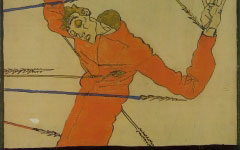Schiele’s Self-portrait as a Saint (1913)
Egon Schiele was only 26 when he painted himself in the guise of a saint. He had become enamored of Gustav Klimt's work, an older Viennese artist whose style he tried to adopt. Two years later he was even described in the media as a Klimt-imitator.1 In analyzing this self-portrait I will now try to show that his work and mind were even more fuelled by Klimt than many realize. Let's take a look.

Egon Schiele, Self-portrait as a Saint (1913) Oil, gouache and black crayon. Leopold Museum, Vienna.
Click image to enlarge.
An artist's identification with Christ or various saints has by now been well-documented on EPPH. Schiele's representation as a saint is not unusual other than in its overt self-representation. Most others, veiled, are not called self-portraits.2 His solid halo, setting like the sun in a field of green, refers to light, vision and divinity. The green screams the creativity of nature and the human mind. His skull-cap divides the marbling of his head between his features below the line and his thoughts a coloured jumble above.
Click next thumbnail to continue
Three green lines escape the field at upper right. They are not accidental and don't look it either. In blue, diagonally opposite those lines in the lower left corner, is the shape of a large S scraped out of his cloak. E and S for Egon Schiele, his initials (see diagram). There is the black line of an L beneath the E which suggests at one time he may have thought of including his whole name, Schiele.
Click next thumbnail to continue
Scraped in the same manner out of the green above the S are, again, a jumble of letters which if looked at carefully spell K L I M T starting at the top with K, L and I before rotating counter-clockwise. The M and T are then turned sideways with the last letter next to the first.
Click next thumbnail to continue
Under the theme Artist as Other Artist you will see many painters who in their art have assumed the identity of an earlier or older artist. Those who have done so include Michelangelo, Rembrandt, Manet and Matisse. Klimt's name hidden in a swirl of fertile green out of which Schiele as a saint emerges suggests that the younger artist thought in some way that he and his revered Klimt were of one mind.
More Works by Schiele
The concise expression of meaning is as aesthetically satisfying in art as it is in poetry

Schiele’s Embrace (1912)
Notes:
1. Agnes Husslein-Arco and Alfred Weidinger, "Egon Schiele: Self-portraits 'An eternal dream full of life's sweet excess' " in Egon Schiele: Self-portraits and Portraits (Munich: Prestel) 2011, p.13
2. See Botticelli's St. Sebastian (c.1473), Albrecht Dürer’s Self-portrait as Christ (1500), Hans Baldung Grien's St. John on Patmos (1511), Andrea del Sarto's St. John the Baptist (c.1523) and many others under the theme The Divine Artist.
Original Publication Date on EPPH: 11 Jul 2014. © Simon Abrahams. Articles on this site are the copyright of Simon Abrahams. To use copyrighted material in print or other media for purposes beyond 'fair use', you must obtain permission from the copyright owner. Websites may link to this page without permission (please do) but may not reproduce the material on their own site without crediting Simon Abrahams and EPPH.




